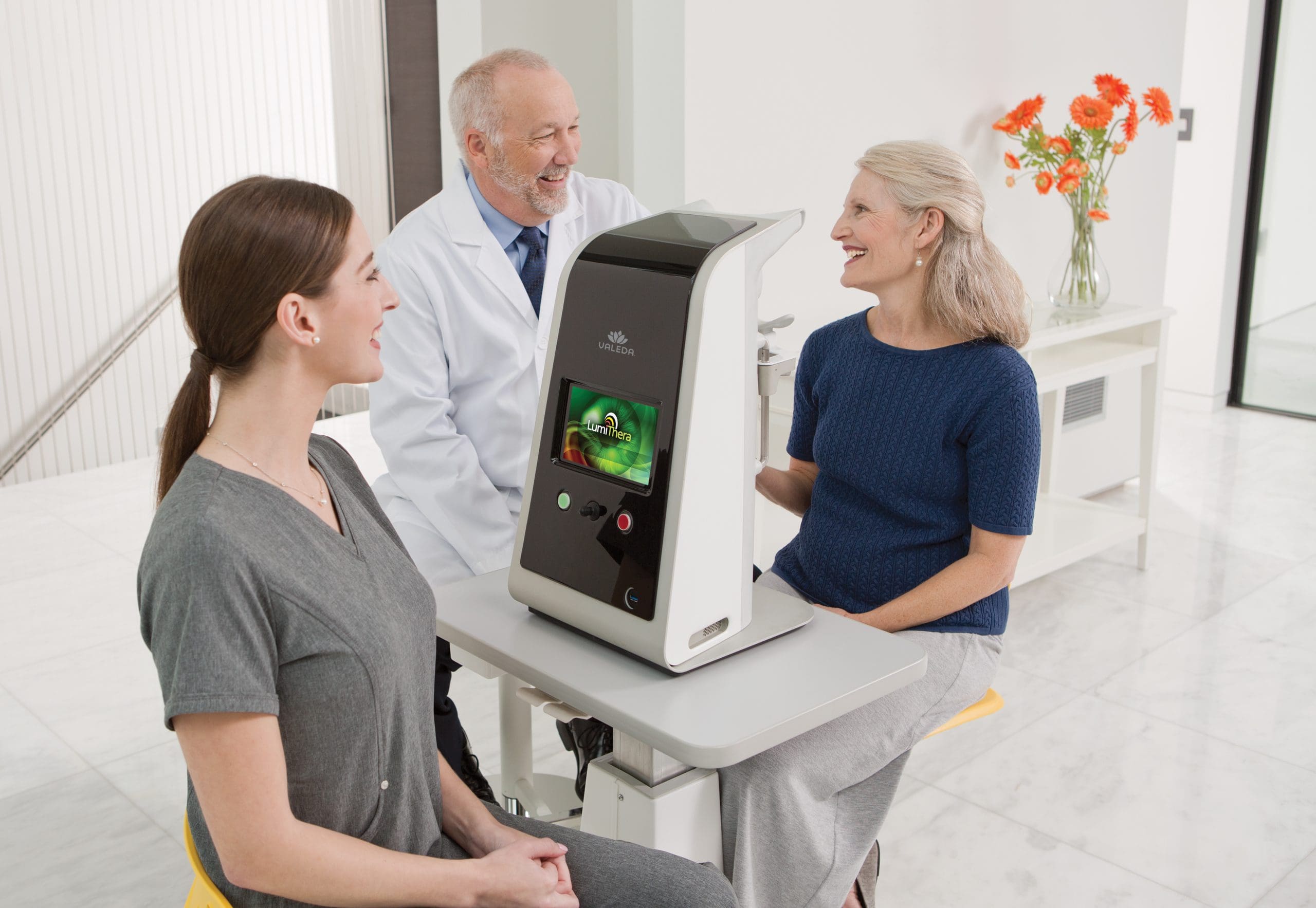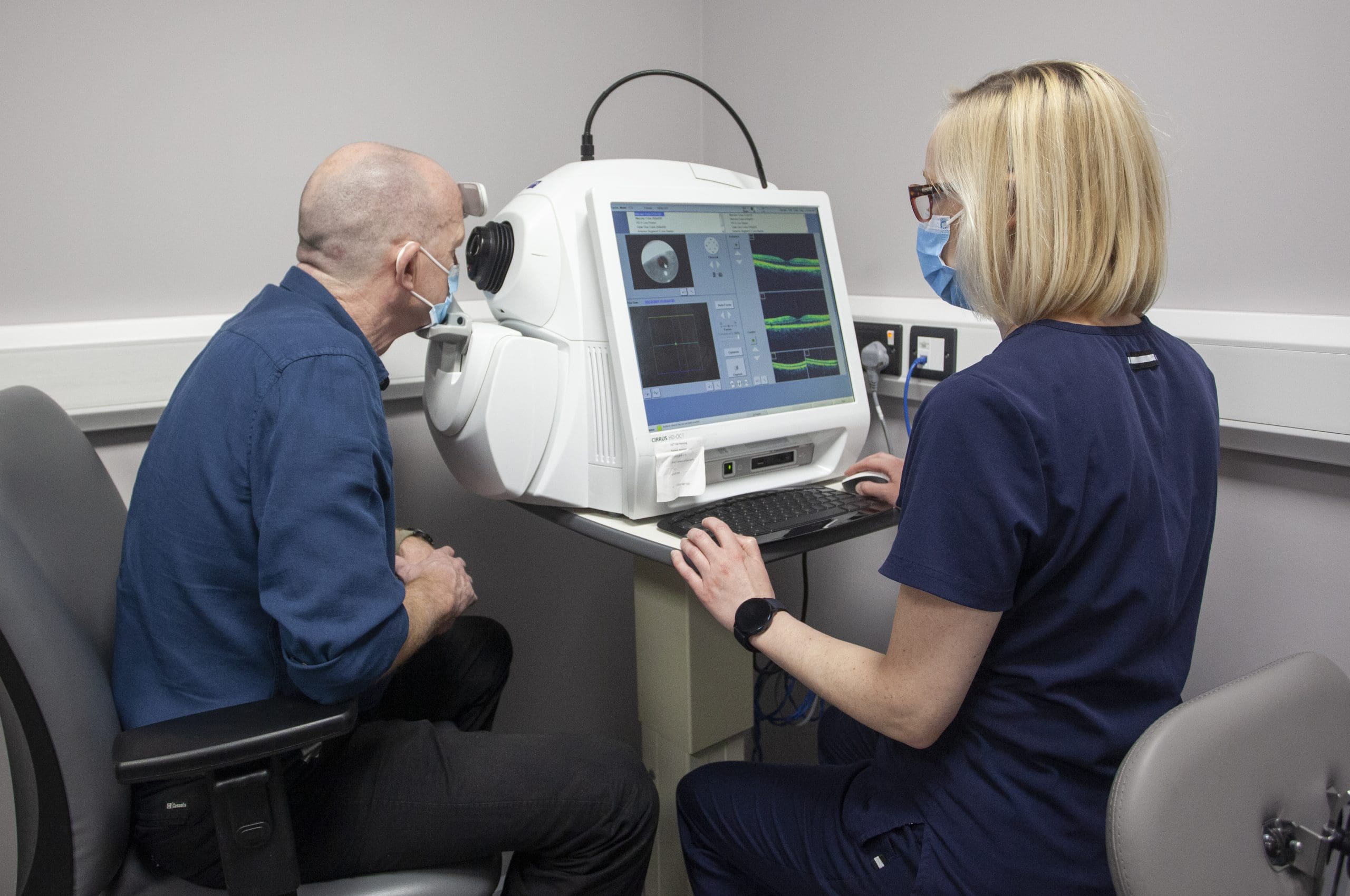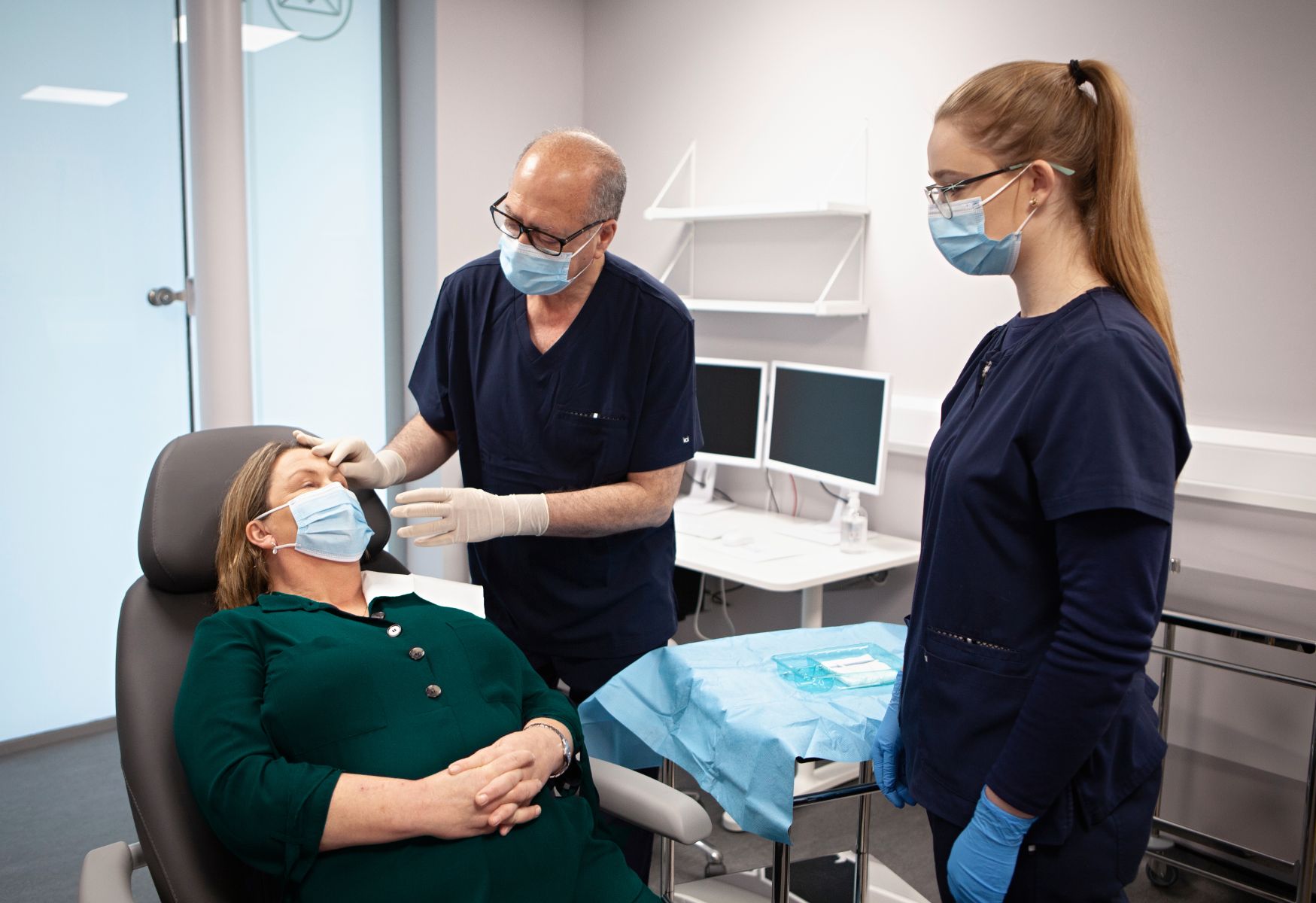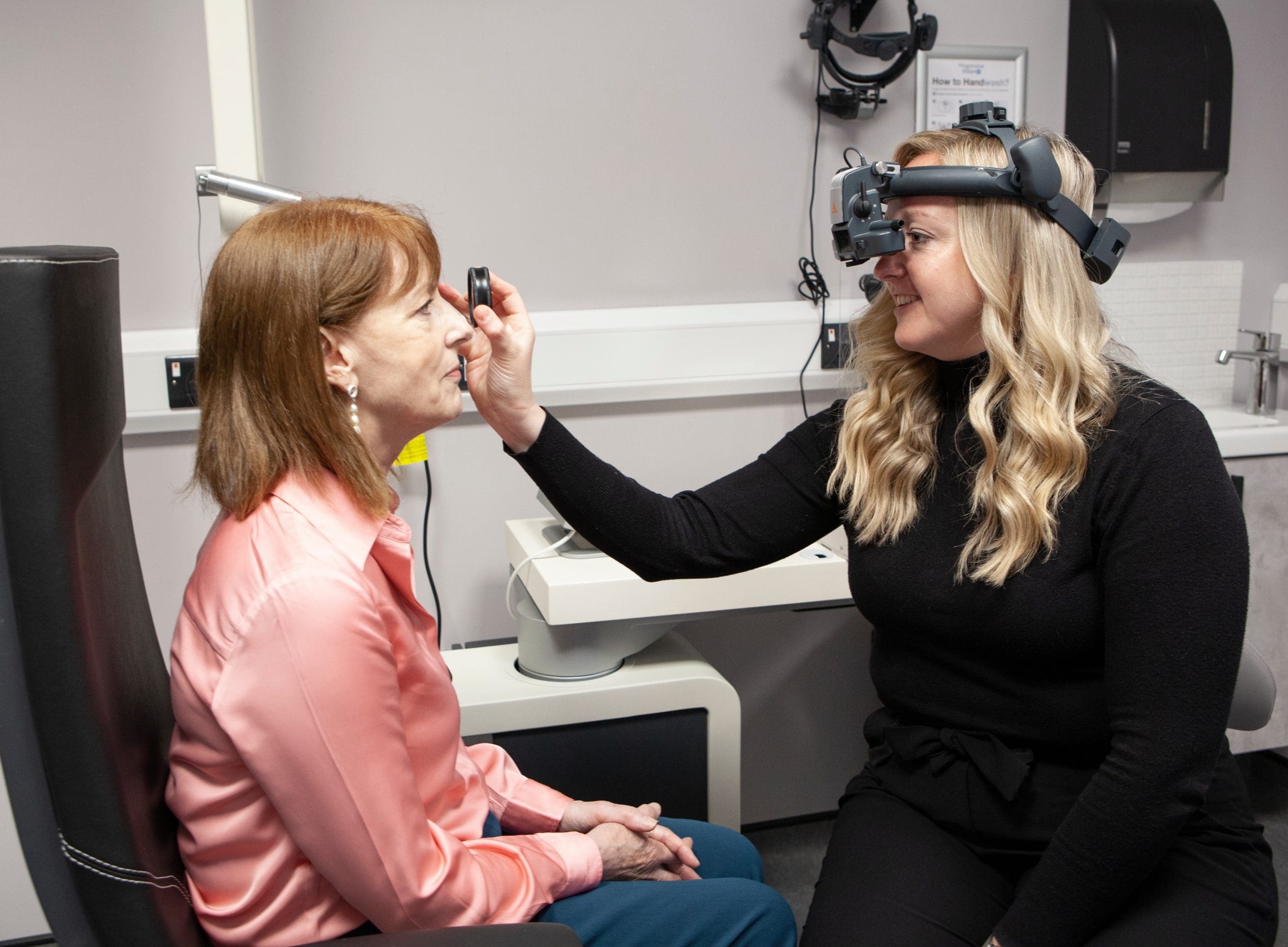A chronic, degenerative condition affecting central vision.
Age-related Macular Degeneration (AMD)
A chronic, degenerative condition affecting central vision
What is AMD?
There are two types of AMD: Dry AMD and Wet AMD
Age-Related Macular Degeneration (AMD) is the number one cause of sight loss in Ireland for those aged over 50. More than 100,000 people in Ireland aged over 50 are living with AMD. The earlier AMD is detected, the sooner it can be treated to reduce its progression.
Symptoms of AMD include
- Seeing wavy or distorted lines instead of straight lines.
- Seeing a blurred spot (or spots) in the centre of your vision.
- Gaps or dark spots (like a smudge on glasses) appearing in your vision.
- Being more sensitive to light.
- The symptoms of AMD progress faster in people with wet AMD.
Dry AMD
- Dry AMD is an eye disease that can affect your eyes as you get older.
- In dry AMD the natural pigment (RPE) under the centre part of the retina (the macula) gets thin and yellow spots appear. The yellow spots are called drusen.
- The thin pigment and drusen combined are called dry AMD.
- Dry AMD is the most common form of AMD, causing 85% to 90% of cases, it develops slowly, and it may eventually lead to loss of central vision.
- Taking oral carotenoid supplements containing lutein (10mg), zeaxanthin (2mg) and meso-zeaxanthin (10mg)
can slow down the progression of dry AMD by increasing the macular pigment levels.


How is DRY AMD treated?
Progressive Vision is proud to be Ireland’s first eye clinic to offer a new treatment for DRY AMD (age-related macular degeneration).
The Valeda Light Delivery System (LDS) is the ONLY available treatment for Dry AMD using a safe, non-invasive and painless therapy – photobiomodulation.
Request an appointment to book an initial suitability assessment at Progressive Vision
How it works
- Photobiomodulation therapy, or cold laser therapy as it has been known previously utilises wavelengths of red, yellow and near infra-red light to rejuvenate on a cellular level.
- Without treatment Dry Age-Related Macular Degeneration (Dry AMD) can progress as you age, leading to vision loss.
- Studies have shown that Valeda photobiomodulation therapy can improve visual outcomes.
- In the ageing eye, cells may become sick leading to loss of function and cell death. Valeda works by stimulating energy production within the cells of the eye and improves their ability to perform their roles. Healthy cells are essential for good eye health.
What’s involved with the Valeda treatment? Do I need any special preparation?
- If you wear glasses or contact lenses, you will be asked to remove them prior to receiving treatment.
- Your eyes will not be dilated for the Valeda treatment. You will be seated comfortably in front of the Valeda Light Delivery System.
- The person administering the treatment will guide you through each step of the treatment, which takes less than 5 minutes.
- Treatment for both eyes will take less than 10 minutes.
- Clinical trials have shown benefits in visual function following treatment 3 times a week for 3-4 weeks.
- This is the recommended treatment protocol for patients with Dry AMD.
- If you miss a treatment, it is recommended to make up the session within the 3-4 week treatment series period.

Wet AMD
In 15% of people with dry AMD fluid forms in or under the central retina.
- The fluid comes from small areas of new blood vessels (neovascularisation) from the deeper blood layer in the eye wall, the choroid. Wet AMD always develops in people who have existing dry AMD
- Wet AMD can cause rapid loss of central vision which can be permanent
How is wet AMD treated?
The treatment for wet AMD is injections of an anti-vascular endothelial growth factor (anti-VEGF) medicine into the eye.
The injections are done in an eye clinic with anaesthetic drops.
The treatment consists of a loading dose of 3 injections 4 weeks apart and then an assessment to see if the wet AMD has responded.
If the wet AMD responds to treatment the person likely will need injections for the rest of their lives, but the interval between injections can often (but not always) be extended to more than 4 weeks. An implant is being developed that is put in the eye as a surgical procedure which can be re-filled at much longer intervals.
Laser surgery is sometimes used to treat some types of wet AMD.
REMEMBER AMD will not cause a total loss of vision. If you have AMD, help and support is available to maximise your remaining vision and to help you maintain an active and independent life. Early detection is important

Frequently asked questions on AMD
Chris White, the Group Chief Executive of the National Council for the Blind in Ireland (NCBI), and ophthalmologist Mark Cahill discuss the ways wet AMD can impact your vision.
Video from www.amd.ie courtesy of ©️ 2021 Novartis Pharmaceuticals Ireland Ltd
Chris White, the Group Chief Executive of the National Council for the Blind in Ireland (NCBI), and ophthalmologist Mark Cahill of Progressive Vision discuss if wet AMD could affect both eyes.
Video from www.amd.ie courtesy of ©️ 2021 Novartis Pharmaceuticals Ireland Ltd
Chris White, the Group Chief Executive of the National Council for the Blind in Ireland (NCBI), and ophthalmologist Mark Cahill discuss the ways wet AMD can impact independence.
Video from www.amd.ie courtesy of ©️ 2021 Novartis Pharmaceuticals Ireland Ltd
Chris White, the Group Chief Executive of the National Council for the Blind in Ireland, and ophthalmologist Mark Cahill discuss whether wet AMD is hereditary.
Video from www.amd.ie courtesy of ©️ 2021 Novartis Pharmaceuticals Ireland Ltd

